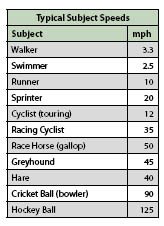articles/Sports/sportsphotography-page13
Sports photography - part 13 of 1 2 3 4 5 6 7 8 9 10 11 12 13 14 15 16 17 18 19
by Mike McNamee Published 01/08/2011

It is useful to analyse Ian Cook's cover shot in detail. It was made at Wembley, one of the largest pitches in the UK (see table) which also has quite a large surround to the bill-boards. The lens was a 300mm, shot in landscape format at a range of 29.9m (we get all this stuff with a meta data extraction script - that is another story!). As a landscape it tells a complete story from the league final playoffs. Sinclair, in white, has just condemned Reading to another year in the Championship league (that's the second division for overseas readers!). The goal-line defender looks on, aghast, the goal keeper (behind him, more maroon socks) is still scrambling vainly backwards.
The prone Reading player (hoops) is beyond help (and later beyond consolation). Sinclair has just reached the 18-yard line which adds a metaphorical underline to Reading's hopes for the season. Despite this your editor is after a vertical format image for the front cover! This is typical, the image makes a perfect doublepage spread but we want a cover - some people cannot be pleased. The solution was to extend the base using Content Aware Fill and to ask some of the spectators on the right to go and sit higher in the stands! We knew that our handiwork was going to be under the masthead at the top and distracted by logos and writing at the bottom.
There are those who hold these sort of antics as unethical and those of us who have a 297x210mm space to fill! The landscape version heads this feature.

Looking closely at soccer yields the following: The pitch sizes specified range between 90-120m in length and 45-90m in width. The sizes of the UK main grounds are tabled (in yards note). This shows a couple of things. The variation is quite small; commentators, for example, go on about the effect that the size of the Wembley pitch has upon players (poor over-paid darlings), whereas in reality it only amounts to a couple of yards. Wembley has a 10-yard distance to the advertising boards behind the goals, six yards at the side.
At a recent England-Germany match there were four photographers on the sides of each quarter and about 20 behind each goal. Our analysis shows that 400mm is about the optimum lens focal length and this indeed is the most popular length from an analysis we made more than a decade ago. In the diagram we have marked out scales at different yardages representing 'head and shoulder', 'single player' and a couple of players engaging. This maybe slightly fanciful, but it does show the sort of coverage you can expect to get and is also something that you can work out before you get to the ground!
The compromise is always between having enough focal length for incidents on the far side of the goal and having enough 'head room' when players jump up for the ball. Cropping, such as we carried out for the cover, can add a little flexibility but nothing can bring back an incident happening way down or across the park, that is why the top publications have more than one camera covering a game.
Please Note:
There is more than one page for this Article.
You are currently on page 13
- Sports photography page 1
- Sports photography page 2
- Sports photography page 3
- Sports photography page 4
- Sports photography page 5
- Sports photography page 6
- Sports photography page 7
- Sports photography page 8
- Sports photography page 9
- Sports photography page 10
- Sports photography page 11
- Sports photography page 12
- Sports photography page 13
- Sports photography page 14
- Sports photography page 15
- Sports photography page 16
- Sports photography page 17
- Sports photography page 18
- Sports photography page 19
1st Published 01/08/2011
last update 18/07/2022 16:35:44
More Sports Articles
There are 25 days to get ready for The Society of Photographers Convention and Trade Show at The Novotel London West, Hammersmith ...
which starts on Wednesday 14th January 2026








